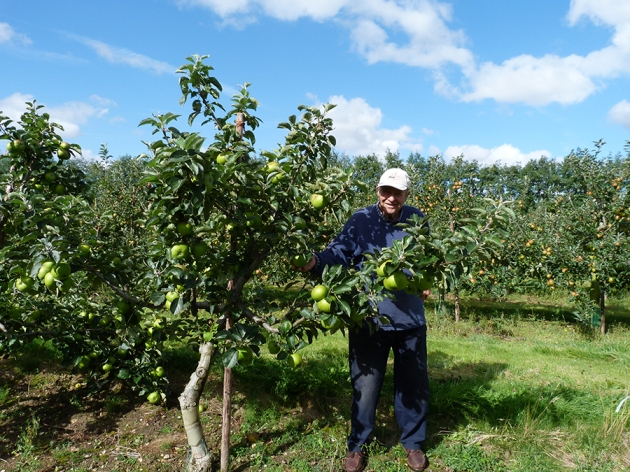If you have ordered a batch of trees from a nursery and, once they have arrived, you are unable to plant them immediately, what can you do?
For a few days, you can KEEP YOUR TREES IN A COLD, BUT FROST-FREE SHED UNTIL THE SOIL ALLOWS YOU TO PLANT.
Before planting, put the roots of the trees in a bucket of water for 10 to 12 hours.
THIS TIME OF THE YEAR, WHEN FRUIT TREES ARRIVE FOR PLANTING IN YOUR GARDEN, OR FOR STARTING YOUR MULTI FRUIT ORCHARD, THE NORMAL AND BEST THING TO DO IS TO HEEL THE TREES INTO A TRENCH OF SOIL, EITHER IN THE GARDEN OR CLOSE TO WHERE THE TREES ARE NEEDED. MAKE SURE ALL ROOTS ARE WELL COVERED WITH CRUMBLY SOIL. YOU CAN ALSO PLACE THE TREES IN A TUB filled with MOIST MULTI-PURPOSE COMPOST. These are the options, if you are unable to plant the trees within 10 days after arrival.
Heeling in procedure:
Dig a trench of a couple of feet long, 8” wide and 6” deep, cover the roots completely with damp crumbly soil and your trees are very happy to sit in that trench for weeks, until you are ready to take them out of the trench and put the trees in their permanent planting position. If rabbits are a problem, protect the trunks of the trees with a spiral plastic guard.
In this way, you are giving yourself plenty of time to plant the trees, when you have got the time to do a good job and the weather is cooperating.
Never forget the soil is the permanent home of the tree. The better the soil is prepared for the transplanting operation, the better the tree will grow. Its food and its drink come via the soil. For a fruit tree, transplanting is the same level of stress as is caused, for us humans, by the upheaval of moving house.
The main points of successful transplanting fruit trees are;
1) don’t plant fruit trees in the shade,
2) don’t plant fruit trees on top of LIVE roots of other trees,
3) Plant fruit trees in a crumbly soil, which is essential for new roots to be able to access the soil’s nutritional store of basic food elements. Lumpy soil on top of the roots, causes starvation of the young fruit tree.
4) Don’t plant fruit trees in water or a water logged soil or frozen soil. The tree will suffocate, as it cannot get hold of the essential oxygen for the roots to live and work properly.
5) Before you put the tree in the ground, knock in a good quality, six foot upright round stake to give the tree support to establish well, in your soil. Make sure the stake is 1’6” deep into the soil.
6) Take your wheel barrow and mix in the wheel barrow your best topsoil with John Innes compost number 3 at a 50/50 ratio.
7) Put that wonderful mixture on top of the roots, move the tree up and down, for this mixture to filter in between all the roots. Firm it gently; making sure the union of the tree is 5 cm above the finished soil level. Not less. Apply the rabbit guard or wire netting surround, to avoid damage to the bark of the tree.
8) Apply a mulch of wet hay or straw, or better still well rotted manure around the trunk of the tree, without touching the stem, over an area of at least 1 square yard. This to be applied after planting is completed.
9) Allow no permanent grass and weeds to get hold on that square yard around the tree trunk. This is essential for the tree to have the full benefit of the provisions you made, in the form of mulch and manure.
10)In the spring, when the tree is beginning to show green, green fly or aphids is a major hazard. Your garden centre will stock the remedy. Secondly, make sure your tree has the benefit of an ample moisture supply. Therefore water the tree on a weekly basis. That is in the period April to September. A full 5 litre watering can for each tree is all you need to do to ensure the tree will grow away well from day one. Do not let the grass encroach on the 1 meter square around the tree trunk. This area must stay grass and weed free for the first 3 years.
11)If you have purchased a pre-trained fan or an espalier, plant the tree WITH the bamboo frame. Plant the tree with the union placed 2 inches above soil level. Not higher as it will affect re- growth of the tree.
12) The angle of the branches may be adjusted by July. If you so wish, you can then loosen the ties and remove the bamboo frame.
13) Greenfly is a real damaging pest, appearing without fail on newly planted fruit trees in the months April, May and June. Your garden centre will stock the various options available to control this very serious pest.
Read more about planting trees here.




